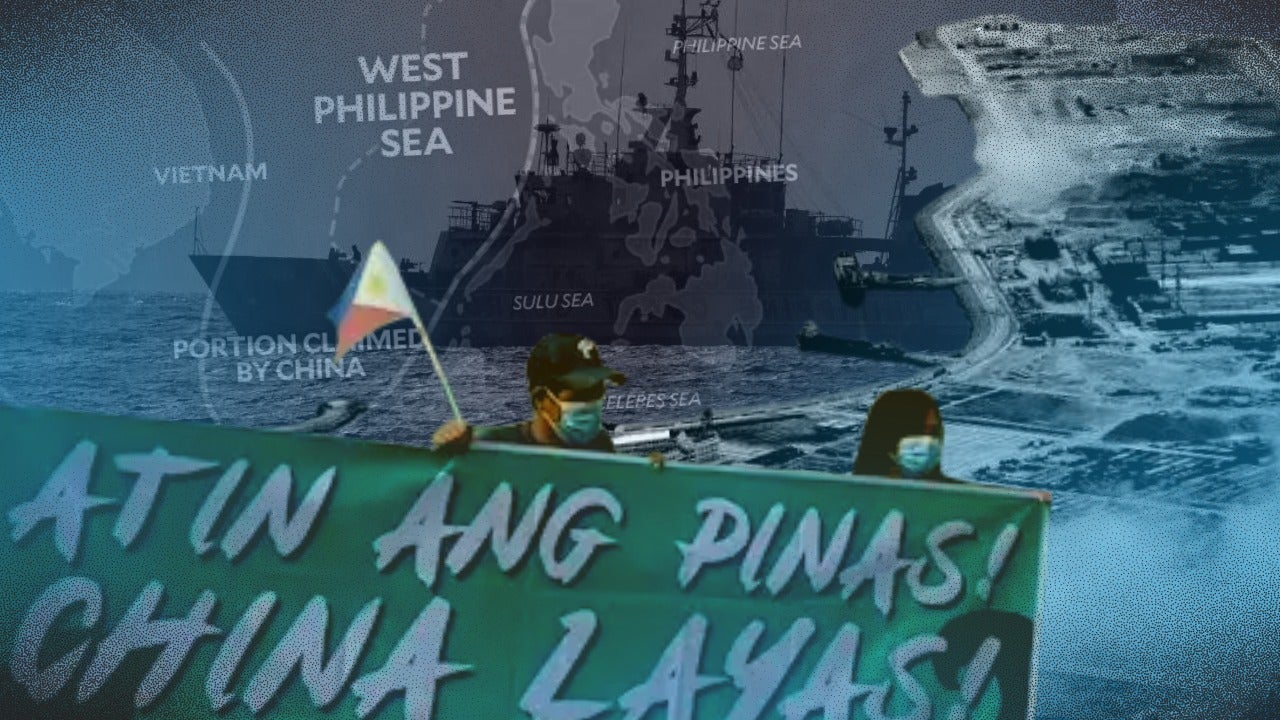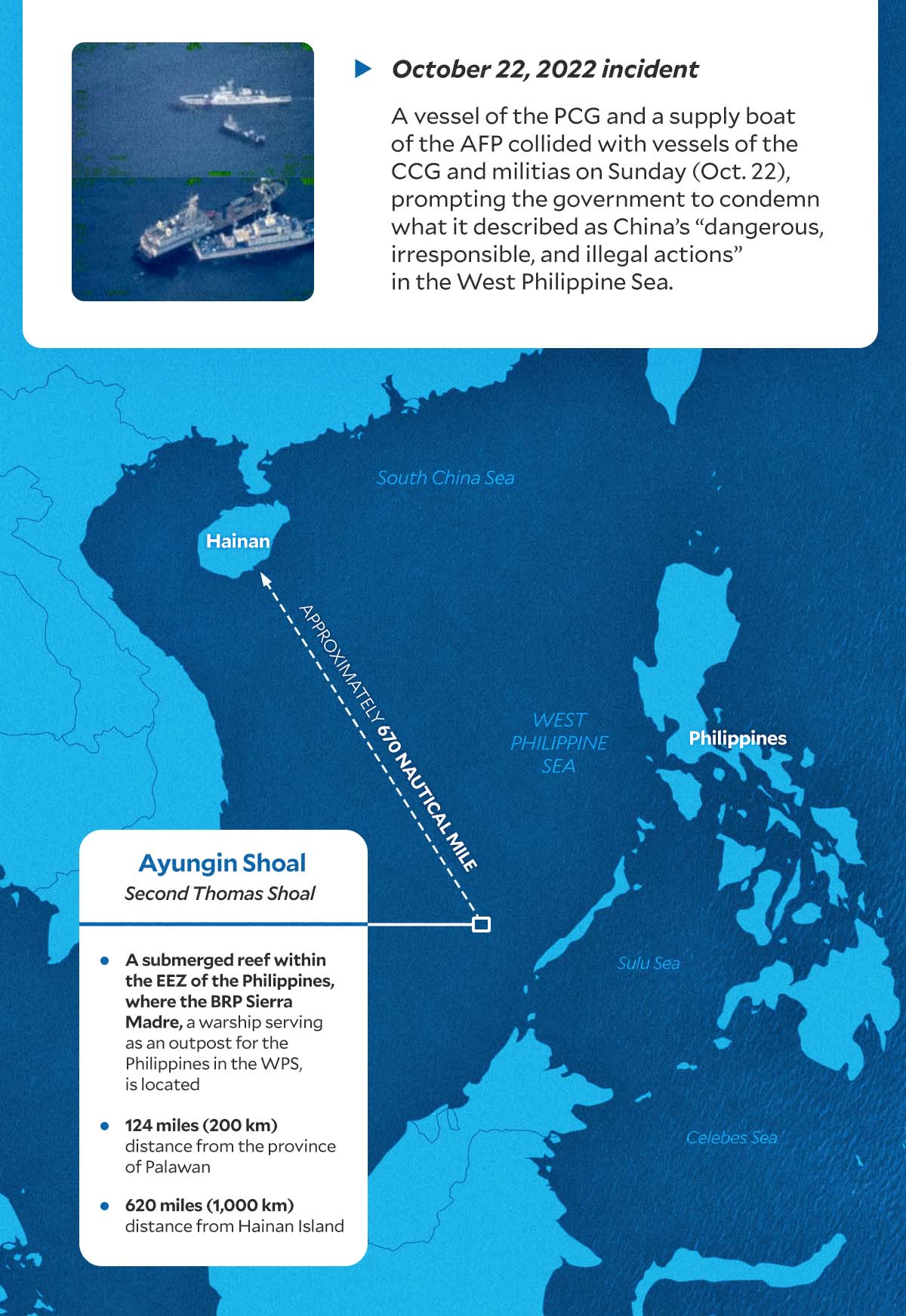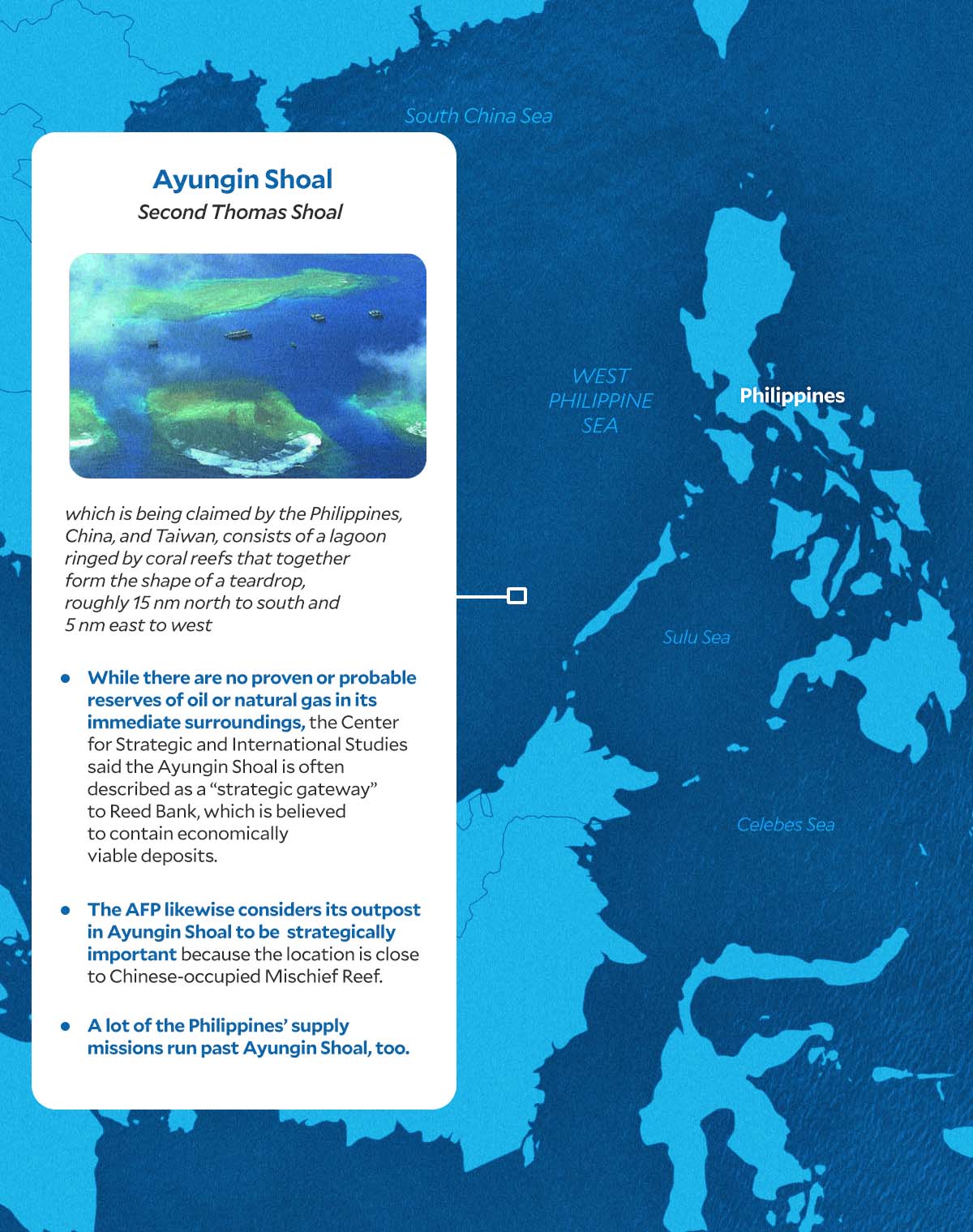BRP Sierra Madre a symbol of PH sovereignty that China wants to destroy
MANILA, Philippines—The BRP Sierra Madre, a World War II-era warship which was intentionally grounded to serve as an outpost for the Philippines in Ayungin Shoal, or Second Thomas Shoal, is the target of China’s relentless, though unarmed, assault on Philippine Coast Guard (PCG) and Armed Forces of the Philippines (AFP) vessels.
Last Sunday (Oct. 22), Chinese vessels collided with PCG and AFP vessels, which were on a routine and regular rotation and resupply (RORE) mission to the dilapidated warship.
READ: Chinese ship collides with PH resupply boat
China kept up its illegal claim to the area, saying the Philippine vessels “intruded in the waters of Ren’ai Jiao,” which is how China calls the area inside Philippine exclusive economic zone (EEZ) in West Philippine Sea.
But Joshua Bernard Espeña, a resident fellow of the think tank International Defense and Security Cooperation, said the Chinese obstruction was not only China’s response to what it described as “trespassing”.
The assault, Espeña said, had a single objective—get rid of the BRP Sierra Madre and eventually have it removed from the West Philippine Sea.
Article continues after this advertisementWhy?
Article continues after this advertisementEspeña told INQUIRER.net via Facebook Messenger that “legally, the BRP Sierra Madre complicates China’s moves.”
“Neither China can fully claim the area if the Philippine Navy is there nor obliterate the vessel lest an act of war with the Philippines and its US ally (and its regional alliance network breaks out),” he said.
PH in its backyard
China claimed that the Philippines disregarded “repeated dissuasion and warnings” and instead insisted on sending vessels “without permission.”
China continued to refuse to recognize the ruling of the Permanent Court of Arbitration (PCA) which had already decided that Ayungin Shoal is a low-tide elevation inside the Philippines’ EEZ.
The shoal is only 124 miles away from Palawan, while China’s Hainan Island, the Chinese area nearest the shoal, is 620 miles away.
But in its desperate bid to double down on its deluded claim on Ayungin Shoal, China said the submerged reef is part of the Spratly Islands, or “its” Nansha Islands, on the basis of its own nine, or even ten-dash line invention, which had already been declared in 2016 by the PCA as baseless and illegal.
“This controversial line is vital to secure its sea lane of communications to deny challengers of its unimpeded maritime supremacy and protect its vast coastlines from afar,” Espeña pointed out.
It was stressed in the 2017 report “Countering Coercion in Maritime Asia” by the Center for Strategic and International Studies (CSIS) that while there are no proven or probable reserves of oil or natural gas in the immediate surroundings, the shoal is a “strategic gateway” to Reed Bank, or Recto Bank.
Recto Bank is believed to contain economically viable resources, like oil and natural gas, and the BRB Sierra Madre is one of the greatest barriers to China’s bid to totally control the waters of South China Sea, including West Philippine Sea.
READ: Pag-asa Island, Ayungin Shoal eyed as marine protected areas
The University of the Philippines Marine Science Institute likewise said “Ayungin Shoal is bordered by a thriving reef system, which is home to many species of fish and other marine life.”
Permanent presence
Since 1999, the Philippines has occupied the dilapidated warship, and based on the CSIS report, China was said to be “monitoring” whether the Philippines has been transporting building materials to the shoal.
Back in 2013, China raised concerns over the Philippines’ reported plans of establishing structures on Ayungin Shoal. With the collision last weekend, China pointed out that it had to take “regulatory measures” against the PCG and AFP vessels “illegally carrying construction materials.”
READ: China raises concerns over PH’s reported development plans on Ayungin Shoal
There is no statement yet from the AFP whether the vessels were carrying construction materials. But in August, the AFP told CNN Philippines that “whatever we do in our commissioned vessel, whatever we do in our exclusive economic zone is none of their (China) business.”
Intentionally grounded in 1999, Espeña said the BRP Sierra Madre “effectively established a permanent presence and 24/7 domain awareness in the Ayungin Shoal, albeit in its dilapidated state.”
This is why China is attacking Filipino moves by blocking RoRe missions to the warship.
“The logic is this: Without provisions, the rusty ship would not survive in the long run due to its sorry conditions. Perhaps, due to natural calamities, Chinese planners might foresee the Filipino ship sinking, and this is a golden opportunity for them to tie loose ends,” Espeña said.
‘Strategic’
It was stated in the CSIS report that the AFP considers the presence of the BRP Sierra Madre in the shoal to be “strategically important,” especially because Ayungin Shoal is close to Mischief Reef, which is being occupied by China despite the PCA declaration that it is a low-tide elevation within the EEZ of the Philippines.
Former Senior Associate Justice Antonio Carpio had said “only the Philippines can erect structures or artificial islands on Mischief Reef,” but in 1995, China seized the reef by explaining that the “stilt structures it built on Mischief Reef were mere shelters for Chinese fishermen.”
Now, Mischief Reef is already home to China’s 590-hectare artificial island, hosting an air-and-naval base with a three-kilometer military grade runway.
As pointed out by Espeña, “China fears Filipino developments in the shoal (Ayungin Shoal) for future fears of the latter’s ability to build a credible anti-access/area-denial (A2/AD), which may hamper the purpose of the 10-dash line.”
“A strong Filipino hold will likely ripple into a stronger American foothold in the First Island Chain,” he said, referring to the chain of islands encompassing Japan, Taiwan, parts of the Philippines, and Indonesia. A geographic construct, the First Island Chain is special to China’s worldview.
Based on the CSIS report, which was written by Green et. al., a lot of the supply lines to the Kalayaan Island Group run past Ayungin Shoal.
Controlling sea’s resources
For China, which is now engaging in deep sea mining of rare metals that are needed for next-generation technology, including advanced weapons systems, having total control of the South China Sea is essential.
Washington Post stated in a report written by Lily Kuo that China’s latest contract, won in 2019, is to “explore for ‘polymetallic nodules,” which are “rich in manganese, cobalt, nickel and copper.”
“Whether working deep at sea or on land at the headquarters of the United Nations’ seabed regulator here in Kingston, Beijing is striving to get a jump on the burgeoning industry of deep-sea mining,” the report read.
READ: In search of rare metals, PH leaves no stone unturned
The metals are needed for everything from electric cars to advanced weapons systems.
It said China already holds five of the 30 exploration licenses that the International Seabed Authority (ISA) has granted to date — the most of any country— in preparation for the start of deep-sea mining as soon as 2025.
“When that happens, China will have exclusive rights to excavate 92,000 square miles of international seabed — about the size of the United Kingdom — or 17 percent of the total area currently licensed by the ISA,” the report read.
Gray zone
Espeña pointed out that the last thing that Beijing wants is to fight Washington now, “given the flaws and challenges posed by its military modernization.”
“China seeks to compensate for this lack through diplomatic slurs, economic sticks, and sophisticated information warfare in traditional and social media to scare off Filipinos and weaken their resolve,” he said.
China, in a statement after the collision, said the Philippines should “stop its infringement immediately,” saying that the Philippines broke its own promise of removing the BRP Sierra Madre. The Marcos administration had denied that there has ever been such a promise.
The Philippines, however, stressed that “we will not be deterred and we will continue to resupply our troops in BRP Sierra Madre despite provocations.”
READ: Gov’t wants to repair, not replace, BRP Sierra Madre – Brawner
For Espeña, China should understand that the Philippines is no longer a pushover, saying “it is a recently emerged middle power that aims to establish a credible archipelagic defense by aligning itself in alliance and multilateral frameworks.”
“No matter how China frames Filipino resolve as an American ‘provocation,’ Filipinos will parry this with a counternarrative that Manila has agency in the scene,” he said.
“In other words, we can resonate with Sun Tzu’s dictum on strategy: appear strong when you are weak. China fears Filipino moves by acting strong since it cannot afford the risks brought to them by Manila,” Espeña added.
“Sure, Filipinos will suffer (and undeniably a tragedy), but Filipino strategic culture is evolving in a way that imposes against even greater giants. The question now is whether the Philippines can indeed sustain these deterrent efforts,” he said.
READ: AFP chief says delivery of BRP Sierra Madre supplies to continue via sea
For comprehensive coverage, in-depth analysis, visit our special page for West Philippine Sea updates. Stay informed with articles, videos, and expert opinions.


